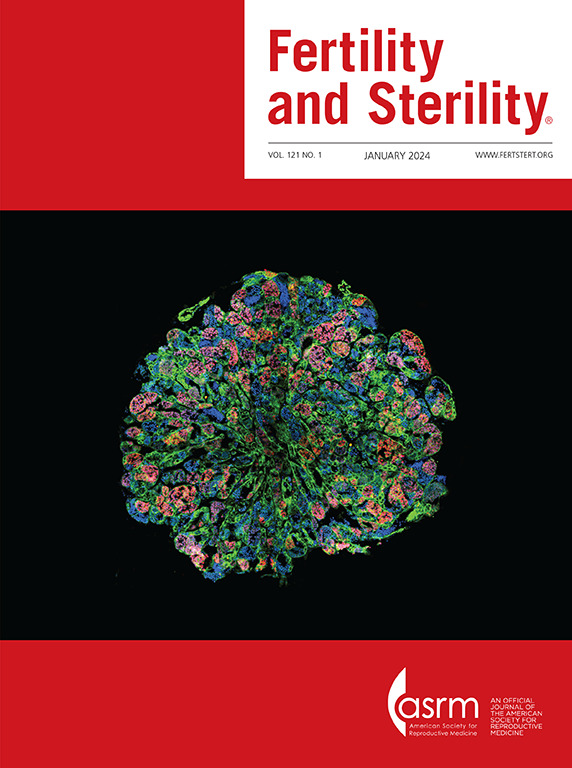High sperm deoxyribonucleic acid fragmentation index is associated with an increased risk of preeclampsia following assisted reproduction treatment
IF 6.6
1区 医学
Q1 OBSTETRICS & GYNECOLOGY
引用次数: 0
Abstract
Objective
To study the association between sperm deoxyribonucleic acid fragmentation index (DFI) and the odds of preeclampsia and other adverse perinatal outcomes after in vitro fertilization (IVF) and intracytoplasmic sperm injection (ICSI) treatment.
Design
A prospective cohort study including infertile couples undergoing conventional IVF or ICSI treatment and their children. Data regarding preeclampsia and perinatal outcomes were derived from the Swedish National Birth Register.
Patient(s)
A total of 1,594 infertile couples undergoing IVF or ICSI treatment and their 1,660 children conceived by assisted reproduction.
Exposure
Sperm DFI measured by Sperm Chromatin Structure Assay.
Main Outcome Measure(s)
The primary outcome was preeclampsia. The secondary outcomes were preterm birth (PTB), low birth weight, low Apgar score, and small for gestational age.
Result(s)
With a DFI level of <20% as a reference, the odds ratio (OR) of preeclampsia statistically significantly increased in the group with a DFI level of ≥20% when IVF was used as the fertilization method (OR, 2.2; 95% confidence interval, 1.1–4.4). Already at the DFI levels of ≥10%, in IVF pregnancies, the OR of preeclampsia increased in a dose-response manner, from a prevalence of 3.1% in the reference group to >10% among those with a DFI level of ≥30%. The DFI was not associated with the OR of preeclampsia in the ICSI group. In the entire cohort, a DFI level of ≥20% was associated with an increased OR of PTB (OR, 1.4; 95% confidence interval, 1.0–2.0).
Conclusion(s)
High DFI level was associated with increased odds of PTB and, in IVF pregnancies, also increased odds of preeclampsia.
Un alto índice de fragmentación del ácido desoxirribonucleico espermático se asocia con un mayor riesgo de preeclampsia después de un tratamiento de reproducción asistida.
Objetivo
Estudiar la asociación entre el índice de fragmentación del ácido desoxirribonucleico (DFI) de los espermatozoides y las probabilidades de preeclampsia y otros resultados perinatales adversos después de un tratamiento de Fertilización In Vitro (FIV) e Inyección Intra Citoplasmática de Espermatozoides (ICSI).
Diseño
Estudio de cohorte prospectivo incluyendo parejas infértiles sometidas a un tratamiento convencional de FIV o ICSI y sus hijos. Los datos sobre preeclampsia y resultados perinatales se obtuvieron del Registro Nacional de Nacimientos de Suecia.
Entorno
Clínica de fertilidad afiliada a la universidad.
Paciente(s)
Un total de 1594 parejas infértiles sometidas a tratamiento de FIV o ICSI y sus 1660 hijos concebidos por reproducción asistida.
Intervención(es)
DFI de esperma medido por ensayo de estructura de cromatina del esperma.
Principales medidas de resultado
El resultado primario fue preeclampsia. Los resultados secundarios fueron parto prematuro (PTB), bajo peso al nacer, bajo puntaje de Apgar y pequeño para la edad gestacional.
Resultado(s)
Con un nivel de DFI de <20% como referencia, la razón de probabilidades (OR) de preeclampsia aumentó de manera estadísticamente significativa en el grupo con un nivel de DFI de ≥20% cuando se utilizó FIV como método de fertilización (OR, 2.2; intervalo de confianza del 95%, 1.1-4.4). Ya en los niveles de DFI de ≥10%, en los embarazos de FIV, el OR de preeclampsia aumentó de manera dosis-respuesta, desde una prevalencia de 3.1% en el grupo de referencia a >10% entre aquellos con un nivel de DFI de ≥30%. El DFI no se asoció con el OR de preeclampsia en el grupo ICSI. En toda la cohorte, un nivel de DFI de ≥20% se asoció con un OR aumentado de PTB (OR, 1.4; intervalo de confianza del 95%, 1.0–2.0).
Conclusión(es)
Un nivel alto de DFI se asoció con mayor riesgo de PTB y, en los embarazos de FIV, también aumentó el riesgo de preeclampsia.
精子 DNA 碎片指数高与辅助生殖治疗后先兆子痫风险增加有关。
研究目的研究精子DNA碎片指数(DFI)与体外受精(IVF)和卵胞浆内单精子显微注射(ICSI)治疗后先兆子痫和其他围产期不良结局发生几率之间的关系:设计:一项前瞻性队列研究,包括接受常规体外受精或卵胞浆内单精子显微注射治疗的不育夫妇及其子女。有关子痫前期和围产期结果的数据来自瑞典全国出生登记册:暴露:通过精子染色质结构测定法测量精子DNA碎片指数:主要结果是子痫前期。次要结果为早产、低出生体重、低阿普加评分和胎龄小:以 DFI < 20% 为参照,采用体外受精作为受精方式时,DFI ≥ 20% 组的子痫前期发生率在统计学上显著增加(OR 2.2;95% CI 1.1 至 4.4;P = 0.02)。在DFI水平≥10%的试管婴儿妊娠中,子痫前期的几率以剂量反应的方式增加,从参照组的3.1%增加到DFI为30%或更高的10%以上。在 ICSI 组中,DFI 与子痫前期几率无关。在整个队列中,DFI≥20%与早产发生率增加有关(OR 1.4; 95% CI 1.0 to 2.0; p = 0.03):DNA片段化指数高与早产几率增加有关,在试管婴儿妊娠中,也与子痫前期几率增加有关。
本文章由计算机程序翻译,如有差异,请以英文原文为准。
求助全文
约1分钟内获得全文
求助全文
来源期刊

Fertility and sterility
医学-妇产科学
CiteScore
11.30
自引率
6.00%
发文量
1446
审稿时长
31 days
期刊介绍:
Fertility and Sterility® is an international journal for obstetricians, gynecologists, reproductive endocrinologists, urologists, basic scientists and others who treat and investigate problems of infertility and human reproductive disorders. The journal publishes juried original scientific articles in clinical and laboratory research relevant to reproductive endocrinology, urology, andrology, physiology, immunology, genetics, contraception, and menopause. Fertility and Sterility® encourages and supports meaningful basic and clinical research, and facilitates and promotes excellence in professional education, in the field of reproductive medicine.
 求助内容:
求助内容: 应助结果提醒方式:
应助结果提醒方式:


